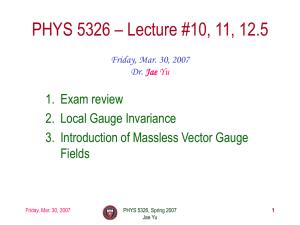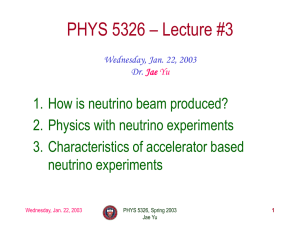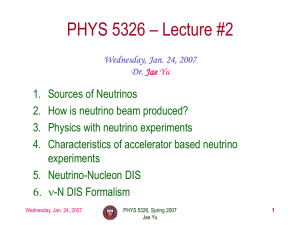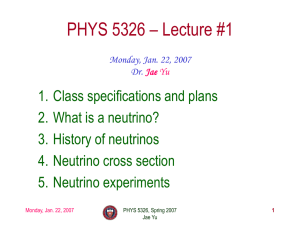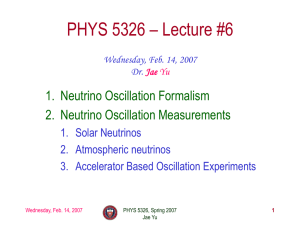Introduction to Neutrinos and EW formalism
advertisement
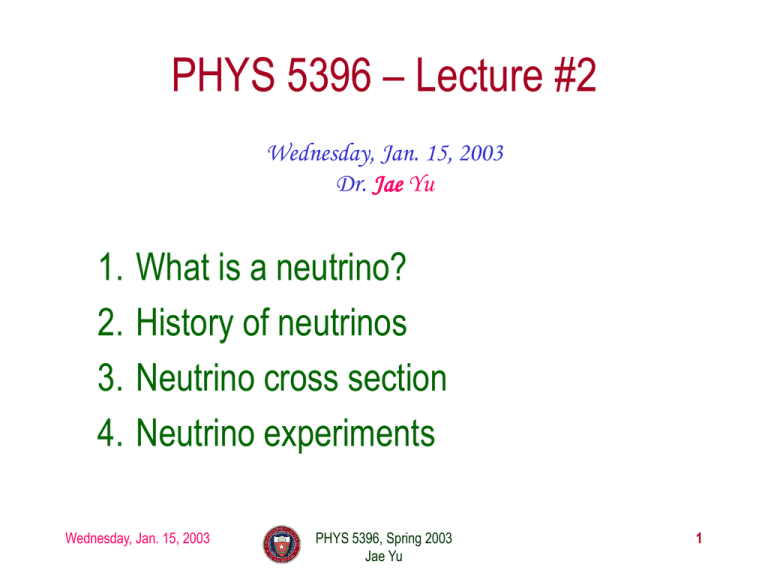
PHYS 5396 – Lecture #2 Wednesday, Jan. 15, 2003 Dr. Jae Yu 1. 2. 3. 4. What is a neutrino? History of neutrinos Neutrino cross section Neutrino experiments Wednesday, Jan. 15, 2003 PHYS 5396, Spring 2003 Jae Yu 1 Reading Assignments • S. Weinberg on Electroweak theory – S. Weinberg, PRL 19, 1264 (1967) • S. Weinberg paper on Standard Model: – S. Weinberg, Rev. Mod. Phys. 52, 515 (1980) Wednesday, Jan. 15, 2003 PHYS 5326, Spring 2003 Jae Yu 2 What are neutrinos? • Lepton species without electrical charge • Only affected by weak interactions, no EM • Have one helicity – we have observed only left-handed neutrinos and right-handed anti-neutrinos – This property led Yang & Lee to parity violation and eventually theory of weak interactions • No mass prescription in the SM Atmospheric and solar neutrino experiments seem to have provided direct evidence that challenges this hypothesis •Measurements show three species only Wednesday, Jan. 15, 2003 PHYS 5326, Spring 2003 Jae Yu 3 Properties of Neutrinos X-sec (cm2) Flavor Spin Masses Magnetic Spin(MeV/T) ne ½ <2.8 ev <5.8x10-20 ~10-38 nm ½ <16~70KeV <4.3x10-20 ~10-38 nt ½ 18.2 MeV <3.1x10-17 ~10-38 Wednesday, Jan. 15, 2003 PHYS 5326, Spring 2003 Jae Yu 4 History of neutrinos • It was noticed at the end of 19th century by nuclear physicists that beta decays do not seem to conserve momentum and energy BIG problem!!! n p n e e • 1931: W. Pauli postulates that the missing energy may be carried by a neutral particle, as a “desperate remedy”. • 1934: Fermi develops a theory of beta decay in which the inclusion of a neutral particle (neutrino) explains many experimentally observed results. Wednesday, Jan. 15, 2003 PHYS 5326, Spring 2003 Jae Yu 5 Neutrino history, cnt’d • 1956: Cowen and Reines detects electron neutrinos from a reactor experiment by detecting photons (a few from neutron capture by Cd nucleus and the other from positron annihilation with an electron) emitted as a result of an inverse beta decay, with a several ms time separation n e p n e • 1956: Yang and Lee develops theory of parity violation of weak interactions Existence of different types from lack of experimental observation of reactions like m e Wednesday, Jan. 15, 2003 PHYS 5326, Spring 2003 Jae Yu 6 Neutrino history, cnt’d • 1962: BNL accelerator experiment proves the existence of muon neutrinos, by producing neutrinos from pion decays and determining the product of interaction to be muons No electrons above the background observed • Late 60’: Proposal of Electroweak theory based on SU(2)xU(1) by Weinberg, Salam and Glashow (Weinberg, PRL 19, 1264 (1967)) • 1970:GIM model (Glashow, PR D2, 1285 (1970)) of second quark family, confirmed experimentally in 1974 •1973: Experimental observation of neutral current interaction at the Gargamelle experiment (bubble chamber neutrino experiment) Confirmation of electroweak theory Wednesday, Jan. 15, 2003 PHYS 5326, Spring 2003 Jae Yu 7 Weak Interaction Formalism n p n e e • Fermi 4-fermion contact interaction to describe nuclear b-decay (E. Fermi, Z. Physik 88, 161 (1934)) p n LFermi 4GF CC CC J J 2 GF 1.16639 105 GeV 2 • The theory begins to violate unitarity at about the momentum transfer scale 100GeV Cross section becomes larger than that from optical theorem Wednesday, Jan. 15, 2003 PHYS 5326, Spring 2003 Jae Yu 8 Introduction of IVB’s and EW Unification • Inspired by the failure of Fermi contact interaction and QED, Weinberg, Salam and Glashow introduced IVB’s exchange to replace Fermi contact interactions p n W- Wednesday, Jan. 15, 2003 PHYS 5326, Spring 2003 Jae Yu 9 EW Formalism • Lagrangian for EW interactions by GSW: - LEW g CC CC g J W J W JNC Z0 g cosW JEM A 2 cosW Charged Weak Neutral Weak EM • Leptonic currents (J’s) couple to vector bosons `n, l W+/- l, `n u, d `u, `d Wednesday, Jan. 15, 2003 CC J J CC 1 5 1 5 n i li u i di 2 2 1 5 1 5 l i n i d i ui 2 2 PHYS 5326, Spring 2003 Jae Yu 10 EW Formalism cnt’d EM J • EM current q j f i f j • Weak Neutral Current J f j NC V j A j 5 2 fj • where Vector and axial-vector couplings are V j I j 2Q j sin 2 W Aj I j • with propagator terms W or Z propagator Wednesday, Jan. 15, 2003 i g mn qm qn / M 2 q2 M 2 PHYS 5326, Spring 2003 Jae Yu 11 Some properties of GSW • GSW model is SU(2)xU(1) gauge group theory with the specified relative coupling strength in the Lagrangian. EM coupling is g sin W e . • GSW Prediction of IVB mass from spontaneous symmetry breaking mechanism, that gives masses to IVB and leptons, is 2 M sin 2 W 1 W2 rM Z • SM Predicts one Higgs boson, giving r=1 Wednesday, Jan. 15, 2003 PHYS 5326, Spring 2003 Jae Yu 12 Linking Fermi to GSW • Using the two Lagrangians of Fermi and GSW and CC propagator 4GF CC CC J J 2 g CC CC g J W J W JNC Z0 g cosW JEM A 2 cosW LFermi - LEW • The coupling g can be written (q2<<M2) W or Z propagator for q M 2 2 ig mn M2 • Effective coupling strengths can be related 4GF g 1 g 2 2 2 MW 2 Wednesday, Jan. 15, 2003 g GF 4 2M W2 PHYS 5326, Spring 2003 Jae Yu 13 Neutrino Cross Sections ( 3) coupling I weak QEM sin 2 W ( 3) coupling I weak 2 Mxy y 2 2 1 y F x , Q 2 xF x , Q 2 1 2E 2 d 2 2GF ME y dxdy 2 y 1 xF x , Q 3 2 nN / En 0.68 10 38 cm2 / GeV Wednesday, Jan. 15, 2003 n N / En 0.35 10 38 cm2 / GeV PHYS 5326, Spring 2003 Jae Yu 14 Sources of Neutrinos: Solar Neutrinos • Nuclear Fusion inside stars with the primary 2 p p H e n e (85%) reaction • Energy spectra Wednesday, Jan. 15, 2003 PHYS 5326, Spring 2003 Jae Yu 15 Sources of Neutrinos:Atm and other • High energy cosmic-ray (He, p, n, etc) interactions in the atmosphere – Cosmic ray interacts with air molecules He p , K – Secondary mesons decay m n m n e – Muons decay again in 2.6ms m e n m n e • Neutrinos from Big Bang (relic neutrinos) • Neutrinos from star explosion • Neutrinos from natural background, resulting from radioactive decays of nucleus • Neutrinos from nuclear reactors in power plants Wednesday, Jan. 15, 2003 PHYS 5326, Spring 2003 Jae Yu 16 Accelerator Based Neutrino Experiments p Wednesday, Jan. 15, 2003 PHYS 5326, Spring 2003 Jae Yu 17 Homework Assignment • Find a method of distinguishing neutrino signs (neutrinos from anti-neutrinos) in an accelerator based neutrino experiment. Wednesday, Jan. 15, 2003 PHYS 5326, Spring 2003 Jae Yu 18
